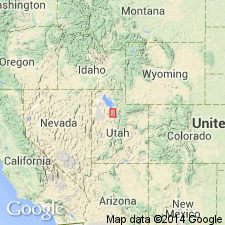
- Usage in publication:
-
- Erda Formation*
- Modifications:
-
- Named
- Dominant lithology:
-
- Limestone
- Shale
- Quartzite
- Sandstone
- AAPG geologic province:
-
- Great Basin province
Summary:
Named as middle formation of Oquirrh Group (rank raised) for Erda siding on the Union Pacific Railroad, Mills Junction quad, Tooele Co, UT in Great Basin province, and is part of Rogers Canyon sequence. Type section measured across center of sec 31, T1S, R3W where formation is 3,606 ft thick, and it overlies Lake Point Limestone (new) of Oquirrh conformably and underlies Kessler Canyon Formation (new) of Oquirrh conformably. Lower contact placed at base of red-brown weathering quartzite. Upper contact placed at base of first thick tan-brown weathering, cliff-forming quartzite. Characterized by cyclically repeated layers of medium-gray limestone and medium-dark-gray, ledge-forming argillaceous limestone, light-brown, slope-forming carbonaceous shale, cinnamon-brown to tan calcareous quartzite, and variegated tan and light brown, cross-bedded, calcareous sandstone. These rocks contrast with gray limestone below and massive red-brown-weathered quartzite above. Limestone ranges from dense, fine grained to cross-bedded and coarse grained. Contains fossil brachiopods, bryozoans, corals, fusulinids, gastropods, and crinoids (listed). Of Middle Pennsylvanian age. Columnar sections. Correlation chart.
Source: GNU records (USGS DDS-6; Denver GNULEX).
For more information, please contact Nancy Stamm, Geologic Names Committee Secretary.
Asterisk (*) indicates published by U.S. Geological Survey authors.
"No current usage" (†) implies that a name has been abandoned or has fallen into disuse. Former usage and, if known, replacement name given in parentheses ( ).
Slash (/) indicates name conflicts with nomenclatural guidelines (CSN, 1933; ACSN, 1961, 1970; NACSN, 1983, 2005, 2021). May be explained within brackets ([ ]).

